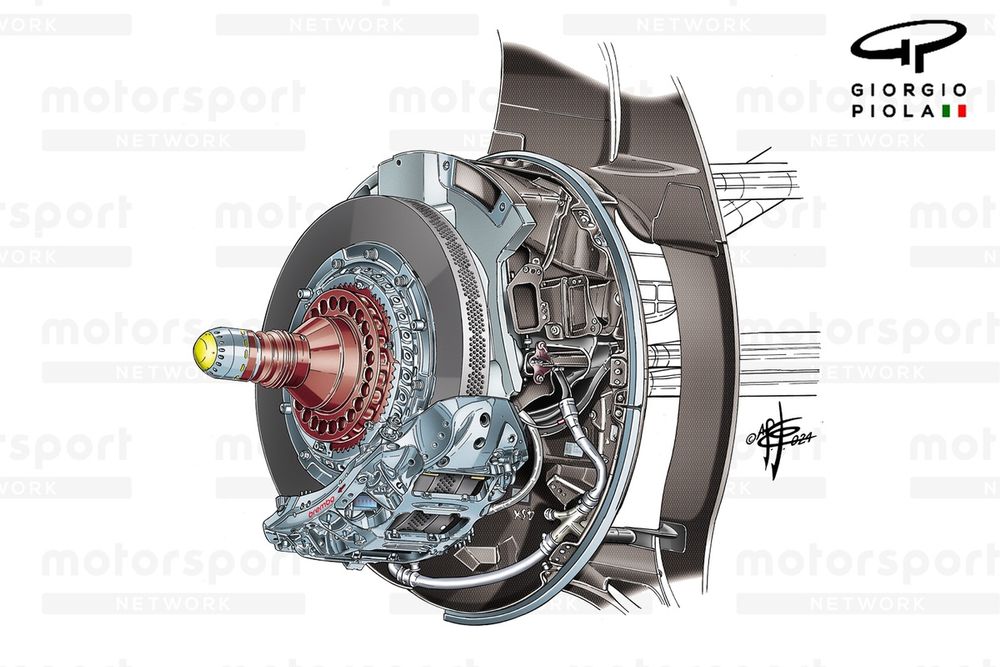Method 1’s drastic 2026 rule adjustments aren’t simply inflicting the groups numerous engineering complications, however they’re additionally “some of the difficult” regulation revamps for brake designs.
The largest regulatory overhaul in fashionable F1 will see the stability between combustion versus electrical energy change from round 80/20 to 50/50. At the moment, F1 vehicles use a 120-kilowatt (161-horsepower) MGU-Ok, however subsequent yr, MGU-Ok energy will increase to round 350 kW (469 hp) whereas the MGU-H unit will probably be eliminated.
Coupled with energetic aerodynamics, the adjustments in energy profile will change how briskly grand prix vehicles will rise up to hurry. However it is going to additionally have an effect on how they’ll cease with a much-increased functionality for regenerative braking, as Brembo’s F1 buyer supervisor Andrea Algeri defined to Autosport.
“That is my fifteenth season in Method 1, so I went by way of totally different adjustments within the form of brakes, vehicles, tyres, totally different wheels. That is actually some of the difficult [regulation changes] for us,” mentioned Algeri, whose firm is F1’s foremost provider.
There are two foremost causes the precise brake {hardware} is being overhauled a lot for 2026. The altering calls for stemming from elevated vitality restoration from the MGU-Ok and a rulebook that’s extra open than the earlier one.
The FIA permits for entrance brake rotors of between 325 and 345 mm in diameter, and rears of 260 to 280 mm. All have a most thickness of 34 mm. It’s a wider vary of sizes for each, which opens up the opportunity of going bigger on the entrance, and smaller on the rear.
The brand new laws additionally permit for as much as three attachment factors for the callipers, as an alternative of two, in addition to extra pistons and pads. Algeri says that is the largest change on the calliper aspect in 20 years and “opens a little bit of freedom for our engineers”.

Ferrari SF-24 Brembo calliper
Photograph by: Giorgio Piola
The actuation of the braking system is conceptually the identical because it has been since 2014. Entrance brakes are purely hydraulic, whereas the rear is brake-by-wire. The driving force’s pedal enter is translated as a torque request that the automotive interprets into a mix of friction and regenerative braking.
The crucial weight battle
In addition to aerodynamics and energy unit efficiency, a 3rd key battleground in 2026 would be the big problem groups face to work their manner in direction of an aggressive new weight restrict. Regardless of the rise in battery measurement and weight, the entire minimal weight restrict has been diminished from 800 to 768kg.
Within the F1 paddock there’s a feeling that few, if any, groups will hit the burden restrict from the beginning of the season, opening a 3rd growth race for the design departments. That has additionally had an impression on brake designs, with groups eager to shave off precious grams wherever they’ll. Greater is not higher by default.
“The groups are on the lookout for the perfect trade-off,” Algeri mentioned. “Not going far greater than the present season, as a result of in the event that they use the biggest dimensions allowed, it might be too heavy. And on the opposite aspect, totally different groups have a special view of the vitality restoration technique.”
Algeri revealed that some groups are going huge on the entrance brakes – although lower than the utmost measurement – and smaller on the rears. Others are taking a special method. Whereas clearly not with the ability to title names, he prompt that a minimum of three groups have been “fairly courageous” of their quest to save lots of weight, an method which is able to probably be copied up and down the grid if it really works.
Nonetheless, you’ll be able to solely go so small on the rear brakes. Each due to the laws, but in addition as a result of the rear brakes have to be able to stopping the automotive with out the help of regeneration. For security causes, the FIA mandates a braking torque requirement for the rear axle of a minimum of 2500 Nm of strain for 150 bar of pedal strain, with out the help of the ability unit.

Mercedes W15 entrance brake duct comparability
Photograph by: Uncredited
“That is mainly to keep away from the loopy situation the place now we have very skinny or very small brakes on the rear, the place if one thing is just not working, it may end up in a giant downside,” Algeri defined. “The design will mirror excessive conditions. You want a disc that’s large enough to outlive in circumstances the place the observe format or the vitality technique forces you to make use of the brakes like prior to now.”
“We are going to in all probability see totally different cooling specs for various tracks,” Algeri added. “For instance, a lightweight responsibility observe will see few holes within the disk to maintain the temperature a bit greater to maintain the carbon within the correct window, whereas for different circuits you depend on excessive cooling disks with a higher variety of holes.”
Why brake producers must rethink their circuit rankings
Usually talking, an even bigger reliance on engine braking means the rear discs received’t see as a lot use as they do now, and due to this fact they may want much less cooling. Carbon-carbon discs require warmth to work, so Algeri says the rears might have fewer cooling holes, or totally different ducting channels to assist preserve temperature. On the flipside, groups ought to want extra cooling for the entrance discs, as a result of these 2026 vehicles needs to be sooner in a straight line.
The vitality deployment challenges that F1 continues to be working by way of can even imply that the calls for on the brakes will differ even higher between the likes of high-speed Monza and Monaco’s twisty road circuit, for instance. However not essentially in the way in which you anticipate.
“We’ve got to rethink the score relating to the braking responsibility of the circuit, as a result of this now’s extra associated to vitality restoration,” Algeri mentioned. “A lightweight responsibility observe when it comes to torque, like Monaco or Singapore, will develop into fairly sturdy for the brakes as a result of you have got numerous time to get better vitality and at a sure level the battery will probably be full, after which it’s important to use the brakes.
The braking technique Algeri touched upon will probably be a vital component of efficiency subsequent yr, with loads of laptime to be gained in how the ability unit is used alone, not to mention the {hardware}. With an even bigger reliance on regenerative braking, groups could have numerous levers to tug to impression the way in which a automotive slows down for a nook, but in addition how the system harvests vitality to be deployed by the MGU-Ok later.
F1 2026 will probably be a software program as a lot as a {hardware} race and it is going to be fascinating to look at.
We wish to hear from you!
Tell us what you want to see from us sooner or later.
– The Autosport.com Staff















